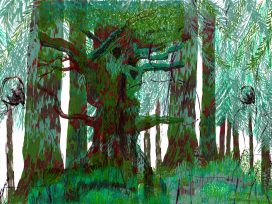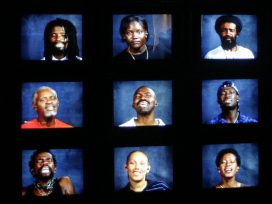
On the border between Poland and Belarus, the Forest has become the subject of a humanitarian crisis. An artist’s report, based on meetings with activists and refugees, charts this contested space. Poetry honours those lost in transit.
Süreyyya Evren looks at how an understanding of form gained through the prism of “unrest” is transposed back into contemporary art and finds that one of the most quintessential features of political art is a never-ending process of searching.
In the past, there was a classical orthodox leftist stance, in accordance with which hardcore socialists believed that political art was best realized when orthodox forms of doing politics were directly applied, like stencils, to art. Art, in this sense, was perceived as a shadow of the real thing (“real politics”). Nowadays, we are confronted with heterodox leftists, who believe that political art is best realized when heterodox forms of doing politics are directly applied, like stencils, to art. Same strategy, different blueprint.
The 7th Berlin Biennale (27 April – 1 July 2012), curated by Artur Zmijewski together with Joanna Warsza and the Voina art collective, provided a good opportunity for thinking through the forms of radically political art events and art works. Berlin was like the exaggeration of an idea. But what’s wrong with experiments like the Berlin Biennale, which “framed political movements within an art exhibition”?1 Is it the absence of art? Or even the absence of a need for art? And where do we find “the political” today? Is there a place in aesthetics for the political – a place that a radical could find? Taking today’s political forms of action as representative of “what is political today”, and representing these in an artwork is one available, functional response to such questions.
Non-hierarchical, grassroots actions spill out onto the streets. But how? And how are these then reproduced in the art world? It is true that today’s radical political actions, protests, events and movements are all about new forms of organizing and acting. It seems like the ideology lies in the forms. So when you apply the way they organize protests to art, you may feel like you are applying “the ideology” of our times, the most radical ideology for transforming societies today.
Yet, there is one crucial detail we are missing here. The ideology of today’s politics does not in fact lie so much in the forms it assumes, as in the search for forms. The forms used represent neither a movement nor the politics of a movement. But an “understanding of form” does represent the movement (needless to add, the characteristics of the movement are based on the idea that no representation can substitute the represented, all representations are temporary). Today’s heterodox, horizontal, anti-authoritarian movements imply a particular understanding of form. This understanding, in practice, means constant experimentation with form, with an ethical compass.
Seeking the political in art today, we are not against forms per se, we do not want formlessness, but we wouldn’t conceive of or accept any form of action, protest, art and art organizing, for example, as “the ideal form for our politics”. This is where the restlessness bites, this is the mouth of the tiger: no form can be reproduced with confidence. It is always an experiment and nobody knows the outcome. We just know we have to be prefigurative. And we need an open eye for experiments. New forms do not always mean something “created”. New experiments do not really require creativity or imaginative power. Sometimes one just discovers a new star, which was of course already there for millions of years.
Directly apply the dominant political forms of your times to art, and you may find that art no longer has an appetite for new forms. After all, just how do we engage with an Occupy-style exhibition? Do we find instant satisfaction once we understand the form? Is it as simple as that? Like a gesture: either we like the gesture or we do not like the gesture, in a Facebook-like fashion. But the “real thing”, I mean Occupy aiming to be Occupy and not an exhibition or a biennale, doesn’t rest when it finds a form. The form may change at any time.
How do we engage with the horizontal quality of the new protest movements? How do we consume them? And how do we consume such grassroots qualities in art? In politics, all you have to do is support a movement and to be a part of it if you can. In the arts, you cannot really be a part of it even if it is “participatory art”. You cannot be the one who is really doing it – since it is all based on the idea that there are no “doers”. And it doesn’t mean much to support such efforts. Supporting the Arab Spring and the activists on Tahrir Square, or supporting the worldwide Occupy movements is one (meaningful) thing. But what would it mean to support the Berlin Biennale?! You may have sent a pizza to Zucotti Park to support the activists. But what would it mean to send a pizza to a gathering during the Berlin Biennale?
I believe the problem or rather the solution lies in discussing how we consume horizontal, grassroots, Occupy-like, bottom-up art events and art works. Rather than focusing on the creative process, I feel the need to discuss how we engage with them… rather than how we “support” them. What do we do with them? And, moreover, why do we feel more relaxed and in control when we face traditional forms? In many cases, if you want to learn something from a text – that is, if you want to control its meaning – you do not want it to be experimental. Which amounts to a politics of sorts: if you want to discuss something crucial you do not use experimental forms. You want to transmit the meaning with minimum risk of loss.
Nevertheless, that was not the case with anti-globalization movements and yet they too proved effective. Tahrir Square was functional and not only “beautiful”. Tahrir Square was not organized through political parties, coalitions, direct orders, hierarchies, plans, master plans and so on, as we all know. And it succeeded. Not only did it mark the end of the Mubarak regime but it also empowered the Egyptians2 – and the revolution continues. The spirit of the approach is captured in a quote from an interview with Swiss-French avant-garde filmmaker Jean-Luc Godard:
REPORTER: Mr Godard, surely you agree that a story must have a beginning, a middle and an end.
JEAN-LUC GODARD: Yes, of course. But not necessarily in that order.
So, do we want a political movement “necessarily in that order”? Seems like we don’t. Do we want art “necessarily in that order”? I’m not so sure about this. Take hypertextual novels such as B. S. Johnson’s The Unfortunates (1968), or Julio Cortazar’s Hopscotch (1963). Both books reflect the 1960s and the same principle: “choose your own order”. The Unfortunates comes as a book in a box. It includes 27 unbound chapters. The “first” and “last” chapters are designated as such. The intervening 25, ranging from 12 pages to a single paragraph, can be read in any order we choose. The book, as an object, comes across as something like an artwork. But when you actually read it, it is pretty easy to lose the unbound chapters or forget which ones you’ve read, along with the order you read them in. If you do not first learn that this is an important experimental book that you should read, if you accidentally come across the box of The Unfortunates, it is very likely that you wouldn’t necessarily continue reading at all.
The narrative turn in historiography, which began with Hayden White, again in the 1960s, gave way to interesting experimental history books where we choose our own order of reading. Hans Ulrich Gumbrecht’s In 1926: Living on the Edge of Time and Sven Lindqvist’s A History of Bombing are two such examples, both great works in their own right. Gumbrecht’s book consists of “text chunks” selected to make you feel as if you were around in 1926, while Lindqvist’s book has 22 alternative beginnings and no end. The problem with Lindqvist’s A History of Bombing is that if you enjoy his approach to the history of bombing you want to learn more. In short, you want to “consume” more of his “stories”. Yet the network-like reading scheme he offers is tiring. You get exhausted. It is pretty easy to lose track of where you’re at. The structure of the book is so appealing, so hypertextual, so non-hierarchical; but the experience of reading is challenging, and it is a bit hierarchical after all, as you are not allowed to read the history of a bombing from a “proper book”. It reminds me of a joke:
– Why do anarchists only drink herbal tea?
– Because proper tea is theft!
I still like the idea behind Gumbrecht’s book, In 1926: writing a book not with a view to comprehending a certain period but writing a book to make you feel as if you are in a certain period. Hands touching the walls of the times. On the other hand, the experience of reading such books, may give a clue about the ways in which we experience horizontal politics in contemporary art. Is proper tea still theft today?
Christy Lange, "7th Berlin Biennale", Frieze 148, (June-August 2012): www.frieze.com/issue/review/7th-berlin-biennale/
See especially Mohammed Bamyeh's "impressions" from the revolution, "The Egyptian Revolution: First Impressions From the Field": www.jadaliyya.com/pages/index/561/the-egyptian-revolution_first-impressions-from-the. And also Mark LeVine's remarks on the "Egyptian black bloc", "Revolution Back In Black": www.aljazeera.com/indepth/opinion/2013/02/201322103219816676.html.
Published 5 June 2013
Original in English
First published by Springerin 2/2013
Contributed by Springerin © Süreyyya Evren / Springerin / Eurozine
PDF/PRINTSubscribe to know what’s worth thinking about.

On the border between Poland and Belarus, the Forest has become the subject of a humanitarian crisis. An artist’s report, based on meetings with activists and refugees, charts this contested space. Poetry honours those lost in transit.

The white saviour, driven by a moral mission, benefits from the oppression they claim to resist. Reactions to the plight of ‘victims’ often fail to translate into concrete actions, leaving those in need of care begging for sympathy. Could acknowledgement of individual complexity to the point of mystery alter this dynamic?